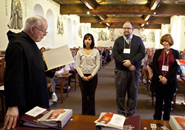The Rule of St. Benedict was written as a guide to living life in community. It was not the first "rule" for Christian followers, but its common-sense approach and Scripture-based guidelines have stood the test of time.
Here are some observations about the Rule from Fr. Harry Hagan, OSB, a monk of Saint Meinrad Archabbey:
St. Benedict wrote his Rule roughly between 530 and 540 A.D. during the decline of the Roman Empire. Despite the chaos of the invading tribes, St. Benedict produced a classic statement on the monastic life.
By "classic," I mean a statement that transcends its historical situation. Though some of the guidelines belong only to its historical context, much in the Rule provides a vision that speaks not just to monastic life, but to life as a Christian and as a human being.
The Rule belongs generally to the wisdom tradition. This includes biblical wisdom such as the books of Proverbs, Ecclesiastes and Sirach.Wisdom literature balances opposing values. For example, "A stitch in time saves nine" is balanced by "Haste makes waste." The wise not only know both sayings, but they also know which one applies to the present situation - whether to act quickly or to move carefully and deliberately.
Wisdom is experiential knowledge that comes from living and not just studying. An understanding of the Rule comes not just from studying, but from living and being a part of a tradition.
Wisdom literature is wider than the Bible. Egypt had a number of "instructions," typically by a sage to his "son."
In similar fashion, St. Benedict opens his Rule by calling on the disciple to listen to the teacher, and so the Rule established the classic master-disciple relationship that can be found in many cultures. This relationship depends on the disciple entrusting himself or herself to the teacher in mutual trust and respect.

An ebook of the Saint Meinrad translation of the Rule of St. Benedict is available through the Private Academic Library Network of Indiana.
Find It Here
Oblates are affiliated with a monastery and are bonded in prayer, love and commitment. They are partners in the prayer and works of the monastery.
Learn More